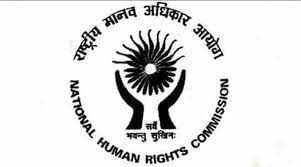UPSC Daily Current Affairs- 26th May 2023 | Current Affairs & Hindu Analysis: Daily, Weekly & Monthly PDF Download
GS-I
Dal Lake

Why in News?
Thousands of fish in the Dal Lake have died over the past few days with authorities blaming a sudden fluctuation in temperature in the region.
About Dal Lake:
- Location:
- It is a lake in Srinagar, the summer capital of Jammu and Kashmir.
- It is surrounded by the Pir Panjal mountains.
- It is integral to tourism and recreation in Kashmir and is named the “Jewel in the crown of Kashmir” or “Srinagar’s Jewel”.
- Spread across an area of around 26 square kilometers, it is the second-largest lake in Jammu & Kashmir.
- The shore line of the lake, is about 15.5 kilometres (9.6 mi), is encompassed by a boulevard lined with Mughal era gardens, parks, houseboats and hotels.
- During the winter season, the temperature sometimes reaches −11 °C (12 °F), freezing the lake.
- The lake is part of a natural wetland which covers 21.1 square kilometres (8.1 sq mi), including its floating gardens. The floating gardens, known as “Raad” in Kashmiri, blossom with lotus flowers during July and August.
- The wetland is divided by causeways into four basins; Gagribal, Lokut Dal, Bod Dal and Nagin (although Nagin is also considered as an independent lake).
- Islands:
- Dal Lake includes 3 islands, 2 of which are marked with beautiful Chinar trees.
- The island located on the Lakut Dal is known as Roph Lank (Silver Island), is marked with the presence of majestic Chinar trees at the four corners, thus known as Char-Chinari (Four Chinars).
- The second Chinar Island, known as Sone Lank (Gold Island), is located on the Bod Dal (Big Dal) and overlooks the holy shrine of Hazratbal.
- Dal Lake is also popular for the floating market (known as Raad) where vendors have their own Shikaras and approach tourists.
Source: The Hindu
Spartly Islands
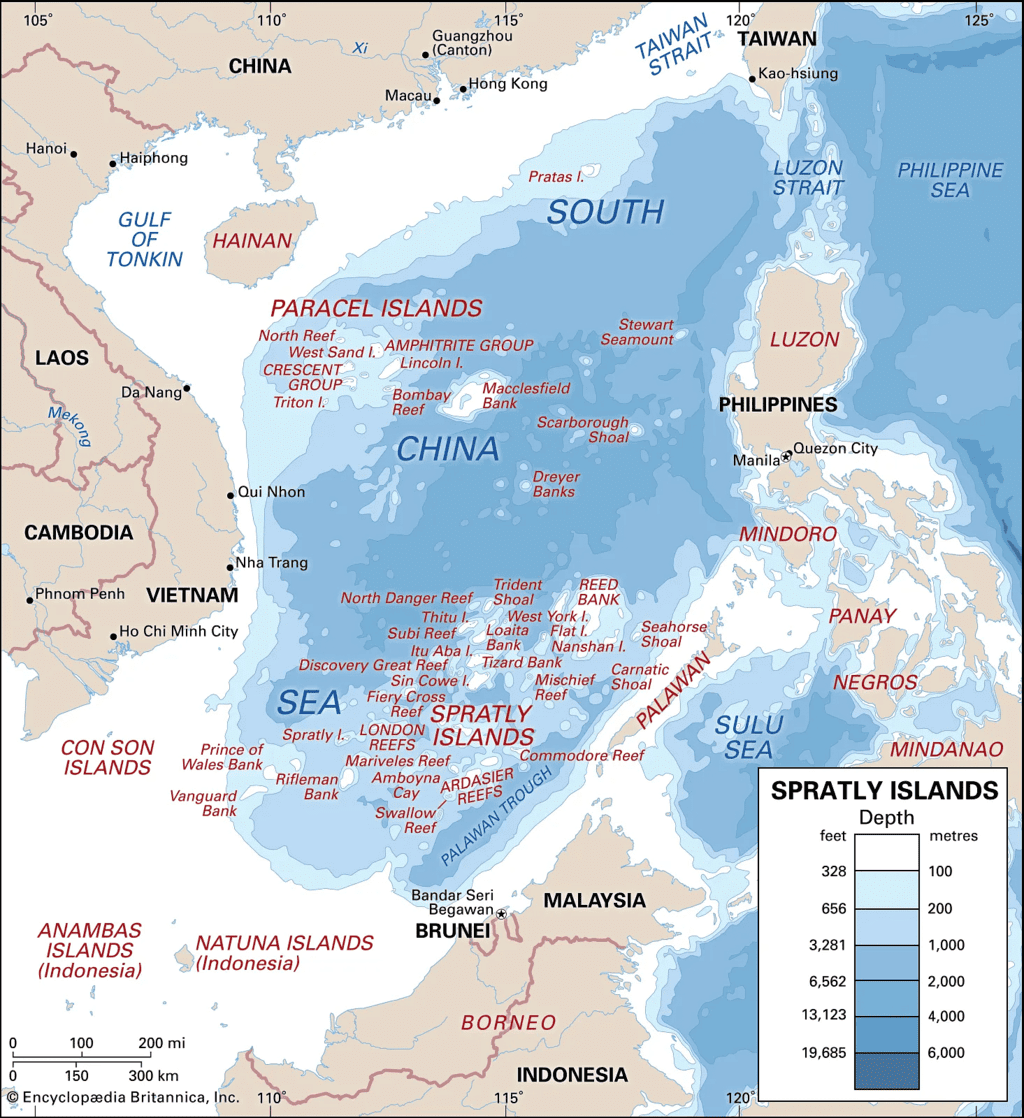
Why in News?
A recent report indicates that the Chinese militarization efforts in the Spartly Islands have transformed these islands into strategic military outposts.
About Spartly Islands:
- Location:
- The Spratly Islands consist of more than 100 small islands or reefs in the South China Sea.
- They are located north of insular Malaysia and are roughly midway between Vietnam and the Philippines.
- Claims:
- They are claimed in their entirety by China, Taiwan, and Vietnam, while portions are claimed by Malaysia and the Philippines.
- Although Brunei did not claim any territory in the Spratlys, it claims an exclusive economic zone over this area that contained a Spratly reef
- They are spread out over a vast area of ocean measuring some 158,000 square miles (409,000 square km).
- Climate: Tropical
- Islands:
- A great number of them are submerged.
- Of the 12 main naturally occurring islets, the largest is the 90-acre (36-hectare) Itu Aba.
- Another, called Spratly Island or Storm Island, measures 900 by 1,500 feet (275 by 450 metres).
- Turtles and seabirds are the only wildlife in these islands. There is no permanent human habitation.
- History:
- France held them between 1933 and 1939.
- During World War II Japan occupied the archipelago and developed it as a submarine base.
- After the war the Chinese Nationalist government established a garrison on Itu Aba, which the Nationalists maintained after their exile to Taiwan in 1949.
- When Japan renounced its claim to the islands in 1951, Taiwan, mainland China, and Vietnam all declared themselves the rightful owners, and the Philippines added a claim based on proximity in 1955.
Source: Newsonair
GS-II
Global Agency Affiliated to UN Rights Body Defers NHRC Accreditation
Why in News?
For the second time in a decade, the U.N.-recognised Global Alliance of National Human Rights Institutions (GANHRI) deferred the accreditation of National Human Rights Commission, India (NHRC-India).
- In 2017, the Global Alliance of National Human Rights granted accreditation to the National Human Rights Commission after a year-long deferment; it had raised concerns about the functioning of India’s statutory human rights body.
What are the reasons for Deferment?
- Global Alliance of National Human Rights Institutions (GANHRI) deferred citing objections like
- Political interference in appointments, involving the police in probes into human rights violations,
- Lack of diversity in staff and leadership,
- Insufficient action to protect marginalised groups
- Poor cooperation with civil society.
Why is accreditation important?
- The Global Alliance of National Human Rights Institutions represents 110 human rights bodies across the world. The accreditation status it gives is based on the United Nations’ Paris Principles, which was adopted in 1993.
- The Paris Principles lists six criteria that human rights bodies must adhere to – mandate and competence, autonomy from government, independence guaranteed by a statute or Constitution, pluralism, adequate resources and adequate powers of investigation.
- Human rights bodies that are fully compliant with these principles are given the “A” status. In case they are partially compliant, a “B” status is given. The global alliance reviews the accreditation every five years.
- Without the accreditation, the National Human Rights Commission will not be eligible to represent India at the UN Human Rights Council
GANHRI (Global Alliance of National Human Rights Institutions)
- It was formerly known as the International Coordinating Committee of National Human Rights Institutions (NHRIs), GAHNRI is a global network of NHRIs.
- It is constituted as a non-profit entity (under Swiss law) and Secretariat support is provided by the Office of the UN High Commissioner for Human Rights (OHCHR).
- The Sub-Committee on Accreditation (SCA) of the Global Alliance of National Human Rights Institutions (GANHRI) has the mandate to review and analyze accreditation applications and to make recommendations to the GANHRI Bureau on the compliance of applicants with the Paris Principles.
- It coordinates the relationship between NHRIs and the UN human rights system.
National Human Rights Commission (NHRC)-India
- About:
- The National Human Rights Commission (NHRC) of India was established on 12 October 1993.
- The statute under which it is established is the Protection of Human Rights Act (PHRA), 1993 as amended by the 2006 Amendment Act.
- Hence, it is a Statutory Body.
- It was set up in conformity with the Paris Principles.
- NHRC has retained its 'A' status of accreditation with the Global Alliance of National Human Rights Institutions (GANHRI) for the 4th consecutive term of 5 years.
- The NHRC, India got 'A' status of accreditation for the first time in 1999 which was retained in 2006, 2011 and 2017 reviews.
- The NHRC is an embodiment of India’s concern for the promotion and protection of human rights.
- The world looks at the NHRC of India as a role model in promoting and monitoring the effective implementation of promotion and protection of human rights.
- Functions of NHRC:
- The functions of the Commission as stated in Section 12 of the Act include.
- Inquiry into complaints of violation of human rights or negligence in the prevention of such violation by a public servant
- Study of treaties and international instruments on human rights
- Make recommendations for their effective implementation to the Government.
- Run Awareness drives for masses on the subject of human rights.
- Encourage the efforts of all stakeholders in the field of human rights literacy not only at the national level but at the international level too.
- Play an active role in coordinating with other NHRIs of the world to enhance awareness from the perspective of human rights.
- host delegations from
- UN Bodies and other National Human Rights Commissions,
- members of civil society, lawyers and political and social activists from different countries.
- The functions of the Commission as stated in Section 12 of the Act include.
- Composition:
- Chairperson, who has been a Chief Justice of India or a Judge of the SC.
- 1 member, who is, or has been, a Judge of the SC.
- 2 members, who is, or has been, the Chief Justice of an HC.
- 3 Members, out of which at least one shall be a woman to be appointed from amongst persons having knowledge or practical experience in matters relating to human rights.
- 7 ex officio members – NCSC, NCST, NCBC, NCW, National Commission for Minorities, National Commission for Protection of Child Rights and the Chief Commissioner for Persons with Disabilities.
- The President appoints the Chairman and members of NHRC on the recommendation of a high-powered committee headed by the Prime Minister.
What are the challenges that NHRC has?
- No Mechanism to Investigate:
- In most cases, NHRC asks the concerned Central and State Governments to investigate the cases of the violation of Human Rights.
- It has been termed as ‘India’s teasing illusion’ by Soli Sorabjee (former Attorney-General of India)
- due to its incapacity to render any practical relief to the aggrieved party.
- Can not investigate case registered after 1 year:
- A large number of grievances go unaddressed because NHRC cannot investigate the complaint registered after one year of the incident.
- Inadequacy of Funds:
- Inadequacy of funds also hampers the working of NHRC.
- Only recommendatory in Nature:
- NHRC can only make recommendations, without the power to enforce decisions.
- The government often rejects recommendations of NHRC or there is partial compliance to these recommendations.
- Highly restricted powers in case of Armed forces:
- NHRC has very few powers related to violations of human rights by the armed forces.
- Post Retirement Destinations:
- Many times NHRC is viewed as post-retirement destinations for judges and bureaucrats with political affiliation.
Way Ahead
- Independent Investigation Staff with appropriate Experience:
- It will give it real teeth to prosecute and check for any violation of human rights.
- Involvement of Civil Societies and other stakeholders:
- There is a need to change the composition of the commission by including members from civil society and activists.
- Adequate Funds and Mandatory implementation of recommendations:
- The institute should be given more independence and autonomy by providing adequate funds.
- Further, the recommendations must be mandatory to implement with very few exceptions and procedures.
Source: The Hindu
Unconstitutional Expansion of Delhi’s Government Authority
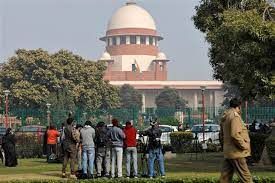
Why in News?
The recent promulgation of The Government of National Capital Territory of Delhi (Amendment) Ordinance, 2023 by the President of India has sparked a debate concerning the scope of the Supreme Court’s verdict and the constitutionality of the ordinance.
Court’s Verdict and interpretations
- In interpreting Article 239AA(3)(a), the Court ruled:
- It determined that the Legislative Assembly of the NCT Delhi has the authority with the exception
- The Court clarified that the executive power of the NCTD is co-extensive with its legislative power, encompassing all matters within its legislative jurisdiction.
- It established that the Union of India has executive power over three entries in List II, which the NCTD does not have legislative competence
- Court’s verdict: Based on these interpretations, the Court concluded that the executive power over services falls exclusively under the Government of the NCTD. This interpretation aligns with the language of Article 239AA(3)(a) of the Constitution.
- However, the subsequent ordinance promulgated by the President on May 19, through the exercise of legislative power under Article 123, expanded the scope of excepted matters in Article 239AA(3)(a).
Facts for prelims
| Article | Description |
| Article 123 | Empowers the President to issue ordinances during Parliament’s recess. |
| Article 239 | Deals with the administration of Union Territories. |
| Article 239A | Provides for the creation of a Legislative Assembly for the Union Territory of Delhi. |
| Article 239AA | Contains special provisions for the Union Territory of Delhi, including the establishment of a Legislative Assembly and governance structure. |
| Article 368 | Outlines the procedure for amending the Constitution. |
| Article 144 | Deals with the binding nature of the Supreme Court’s judgments on all courts and authorities in India. |
| Article 213 | Empowers the Governor of a state to promulgate ordinances during the recess of the state legislature. |
Why the constitutionality of the ordinance in this regard is highly questionable?
- Bypassing the constitutional amendment process: The ordinance expanded the scope of excepted matters in Article 239AA(3)(a). However, such an expansion would require a constitutional amendment under Article 368. By utilizing Article 123, which grants legislative power during the period of Parliament’s recess, instead of following the constitutional amendment process, the ordinance may be considered unconstitutional.
- Limits of legislative power: The power conferred on Parliament under Article 239AA(3)(b) is to make fresh laws, not to directly amend Article 239AA(3)(a) of the Constitution. Therefore, altering the scope of Article 239AA(3)(a) would require a constitutional amendment under Article 368.
- Colorable exercise of power: By expanding the scope of excepted matters without amending the Constitution through the appropriate procedure, the ordinance may be seen as a colorable exercise of power. It is essential to adhere to the constitutional amendment process to ensure the validity and legitimacy of legislative actions.
Implications of the Court’s Judgment
- Binding nature: When a Constitution Bench of the Supreme Court declares or interprets the law, its decision becomes binding on all courts and authorities in India according to Articles 141 and 144, respectively. The Court’s interpretation of Article 239AA(3)(a), which affirmed the exclusive executive power of the Government of the National Capital Territory of Delhi (NCTD) over services, is legally binding on all courts and authorities. This means that the government and other entities must adhere to this interpretation.
- Limits on executive power: The Court’s verdict clarified the extent of executive power held by the NCTD and the Union of India. This delineation of executive power sets clear boundaries and ensures a proper division of responsibilities between the NCTD and the Union government.
- Requirement of constitutional amendment: The Court’s verdict highlighted the need for a constitutional amendment to alter the scope of Article 239AA(3)(a) and expanding the exceptions in Article 239AA(3)(a) would require a constitutional amendment under Article 368. This reaffirms the importance of adhering to the constitutional amendment process to ensure the integrity and legitimacy of any changes made to the Constitution.
- Questioning the validity of the ordinance: The Court’s judgment raises questions about the validity of the subsequent ordinance promulgated by the President. The ordinance, which expanded the scope of excepted matters in Article 239AA(3)(a), may be deemed unconstitutional.
Conclusion
- The Government of National Capital Territory of Delhi (Amendment) Ordinance, 2023 raises constitutional concerns. Its expansion of excepted matters without a constitutional amendment is likely to be struck down. The ordinance is void ab initio and represents a colorable exercise of power. Only Parliament, through proper amendment procedures, can alter the scope of Article 239AA(3)(a).
Source: The Hindu
International Booker Prize

Why in News?
Time Shelter, written by Georgi Gospodinov and translated into English by Angela Rodel, has won the International Booker Prize 2023. This is the first time a novel originally published in Bulgarian has won this annual award.
About
- The International Booker Prize is given every year to a foreign language book translated into English and published in Britain or Ireland.
- From 2016 onwards, the prize equally recognises the work of both author and translator.
- Novels and collections of short stories are both eligible.
- Last year, the prize went to Geetanjali Shree’s Tomb of Sand, translated into English by Daisy Rockwell.
Booker Prize
- It is distinct from the Booker Prize which is awarded to the best work of fiction written in English and published in the UK and Ireland.
- Indian writers like Arundhati Roy and Aravind Adiga have won it in the past.
Source: Indian Express
GS-III
What is Angel Tax?
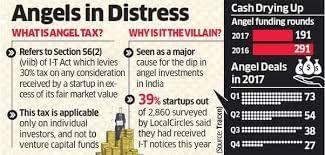
Why in News?
The Finance Ministry recently exempted investors from 21 countries from the levy of angel tax for non-resident investment in unlisted Indian startups.
About Angel Tax:
- It is a tax levied on the capital raised via the issue of shares by unlisted companies if the share price of issued shares is seen in excess of the fair market value of the company.
- The excess funds raised at prices above fair value is treated as income, on which tax is levied.
- Angel tax essentially derives its genesis from section 56(2)(viib) of the Income Tax Act, 1961.
- The finance act, 2012 introduced section 56(2)(viib) in the IT act which taxes any investment, received by any unlisted Indian company, valued above the fair market value by treating it as income.
- Rate: It is levied at a rate of 30.9% on net investments in excess of the fair market value.
- Objective: To deter the generation and use of unaccounted money through subscription of shares of a closely held company, at a value which is higher than fair market value.
- In 2019, the Government announced an exemption from the Angel Tax for startups on fulfillment of certain conditions. These are,
- The startup should be recognized by the Department for Promotion of Industry and Internal Trade (DPIIT) as an eligible startup.
- The aggregate amount of paid-up share capital and share premium of the Startup cannot be more than ₹25 crores. This amount does not include the money raised from Non-Resident Indians (NRIs), Venture Capital Firms, and specified companies.
- For angel investors, the amount of investment that exceeds the fair market value can be claimed for a 100% tax exemption. However, the investor must have a net worth of ₹2 crores or an income of more than ₹25 Lakh in the past 3 fiscal years.
- Previously, angel tax provisions were applicable only for investments received from resident investors.
- However, Finance Bill 2023 has extended its applicability to non-resident investors as well.
Source: Indian Express
Fastest Supercomputers
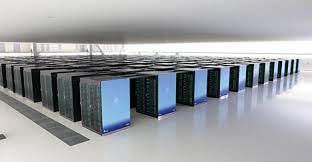
Why in News?
The Ministry of Earth Sciences has said that India is set to dramatically scale up its super-computing prowess and install an 18-petaflop system over the course of this year.
What is a Supercomputer?
- A supercomputer is a computer that performs at or near the highest operational rate for computers.
- These computers leverage a memory block along with multiple central processing units grouped into ‘compute nodes’ – sometimes tens of thousands of nodes.
- Currently India’s most powerful, civilian supercomputers — Pratyush and Mihir — with a combined capacity of 6.8 petaflops are housed at the Indian Institute of Tropical Meteorology (IITM), Pune, and the National Centre for Medium Range Weather Forecasting (NCMRWF), Noida, respectively.
- The new supercomputers too will be housed at the IITM and NCMRWF.
- The fastest high-performance computing system in the world is currently the Frontier-Cray system at Oakridge National Laboratory, United States.
Petaflop system
- Flops (floating point operations per second) are an indicator of computers processing speed and a petaflop refers to a 1,000 trillion flops.
- Processing power to such a degree greatly eases complex mathematical calculations required, for among other things, forecasting how the weather will be over the next few days all the way up to two-three months ahead.
Source: The Hindu
|
59 videos|5398 docs|1143 tests
|


